In this CMO panel from SaaStr, Rick Schultz, CMO at Databricks, Janine Pelosi, Former CMO at Zoom, and Ryan Carlson, Former CMO at Okta, joined Carilu Dietrich, Advisor at Hypergrowth B2B Startups to talk about the seven biggest mistakes CMOs make. These CMOs have all taken their companies from the early stages through IPOs and have been apart of multi-billion dollar organizations. Here are the 7 big mistakes they made, so you can avoid them.
Mistake #1: Not Participating in Company Strategy
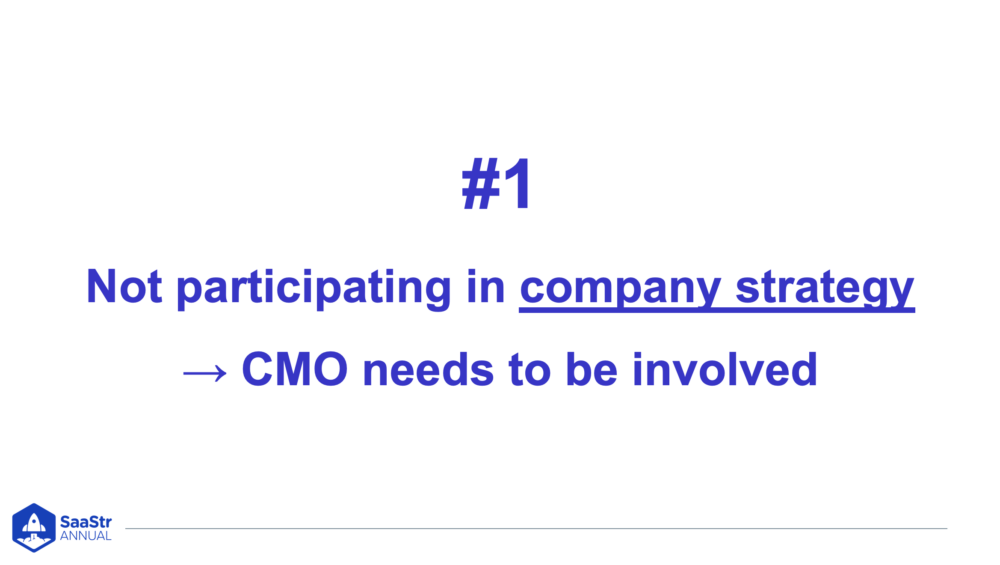
CMOs need to be involved, and a common mistake founders make is not involving them in strategic conversations within the C-suite. Coming in early on to start the marketing function at Zoom, it was all about driving revenue and surviving. At different stages, the Marketing department of your org and your company may be focused on different initiatives to try to meet a mutual outcome.
“It was always thinking about the company first,” said Janine Pelosi of Zoom. “Typically that was the marketing hat in my case, but sometimes it was the sales hat or thinking about finance or other areas of the business. So you need context from leadership to what you ultimately need to deliver on in your function to be successful. And without that context, you lose out.”
To be a successful CMO, you need context from your CEO and the rest of the executive team. If you have context, you have a seat at the table. If you’re just given a plan without context as to why the business is focused on those goals, you’re unlikely to meet it or succeed. When you get everyone on the leadership team in a room to come up with the best ideas, those people take ownership of the ideas. Everyone within the company needs the why in that context because it’s critical for a company to move in the same direction.
Ryan Carlson, Former CMO at Okta added, “Everybody thinks about marketing as ‘I’m launching this product or I’m launching this company or I’m trying to get buzz, get recognition, get awareness. I’m trying to generate pipeline. Yes, marketing has to do all those things, but I think if marketing is going to do its job well, it has to be involved in the company core, the story for why does this company or product exist? What do we value?”
Mistake #2: Not Building the Right Leadership Team
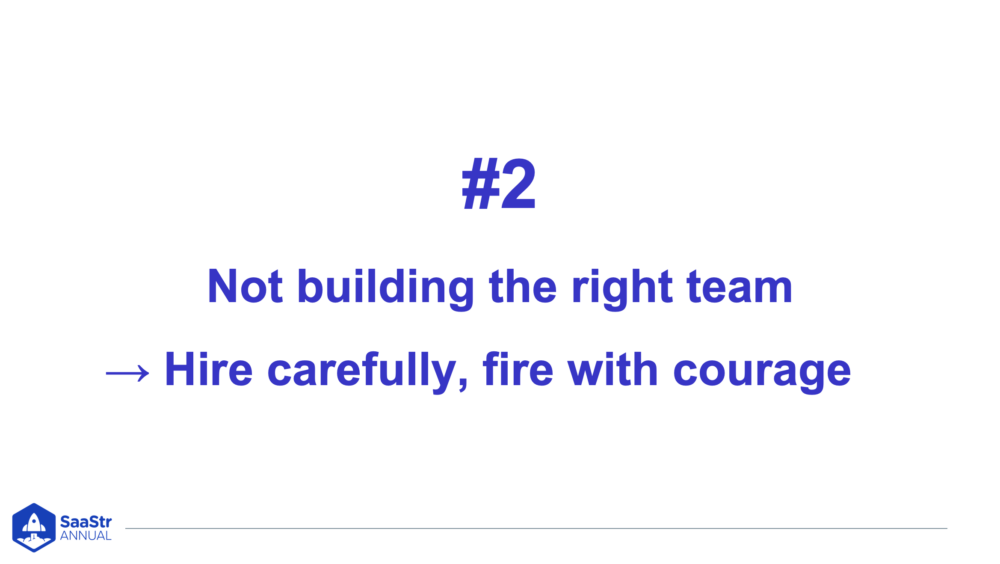
A mistake CMOS often make, especially during hyper-growth phases, are compromising on the principles or core values of the company during the hiring phase. You want to build the right leadership team around you, and at places like Databricks, there was nothing more important than building the right team.
During their recent hyper-growth phase, Rick Schultz CMO at Databricks hired a lot of marketers. But he often ran into a conundrum because:
- They had a very high bar.
- They needed to move quickly.
These two things are often opposing: trying to find the best of the best and needing to move fast. Leading him to some of his biggest mistakes when hiring:
- Not investing enough time.
- Compromising on hiring principles and values.
Schultz explained: “So I always say, ‘Think about how many hours this search is going to take by the time you do the research, talk to candidates, do your outreach, interview candidates many times, do your back channel reference checks — all of that adds up. If it’s going to take 200 hours, and you need to spend 20 hours a week to get it done that quarter, if you spend 10 hours a week, it’s going to take you two quarters. And a quarter is an eternity in a startup. That’s the thing.”
So you cut corners, skip a few steps, and maybe aren’t as diligent on the candidate as you should be if you had more time. It leads CMOs to not spending enough time on hiring, and it can also lead them down a path where they start to compromise on the company and hiring principles because they want to move on in the hiring process and get someone in the role. So how do you combat this when you’re strapped for time?
“In our case, the principle is we look for are long-term company builders,” Schultz said. “We look for other people who’ve been, five, six, seven, eight years in the same role and been promoted and built other companies. Longevity matters a lot. And then every now and then, we fall into a trap where we convince each other that it’s okay to hire someone who’s moved around a lot more. And so, we bend our principle,s and 99% of the time we regret it. You should have just stuck to your original principle.”
Mistake #3: Setting the Wrong Metrics and Goals
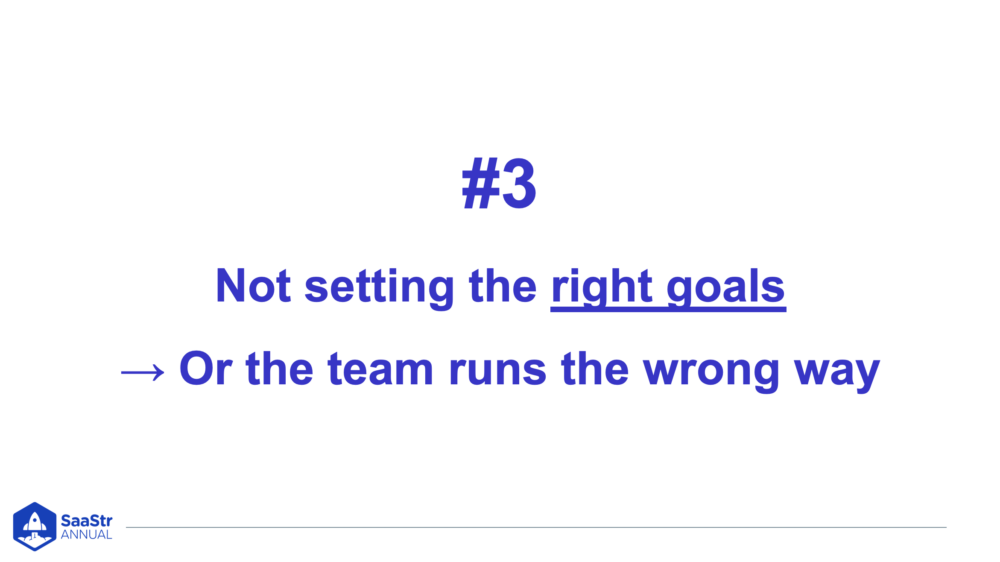
Ryan at Okta made the wrong choice on short-term metrics and led his team in the wrong direction as CMO. He admits, “I thought I was being a really great leader. I thought I was being so smart, so strategic. I was going to tell everybody that pipeline mattered.”
He wanted his team to know that pipeline mattered above anything and everything else. Pipeline came first. And for his marketing team, it didn’t just apply to marketing, demand gen, or brand, or PR. It was for everyone – product marketing, SDRs who reported in marketing, marketing operations, and sales enablement. Everyone had to be focused on pipeline or bust.
You’d think this would work right? But what Ryan found out the hard way was that he was focusing everyone in Marketing on pipeline at the expense of everything else.
The aha moment came when they were organizing a dinner between Okat’s CEO and the CEOs of Fortune 500 companies. “And the person who was organizing it, she said to me, ‘Ryan, I don’t think we should do this dinner.’ I said, ‘Why?’ She said, ‘I’m not going to show any stage two pipeline created from this activity.’ And that’s when I wasn’t happy with that conversation, but I was more unhappy with myself because I put us in that situation.”
A CEO-style dinner with the right prospects and CEOs of Fortune 500 companies might not have Stage 2 impacts on pipe, but it will certainly have an impact elsewhere in the funnel, either on the way to pipeline, or helping accelerate later stage pipeline. At that point, Ryan implemented a balance scorecard at Okta that looked at pipeline generation and other metrics to balance marketing activities and goals.
Mistake #4: Not Setting Up Marketing Attribution Tracking
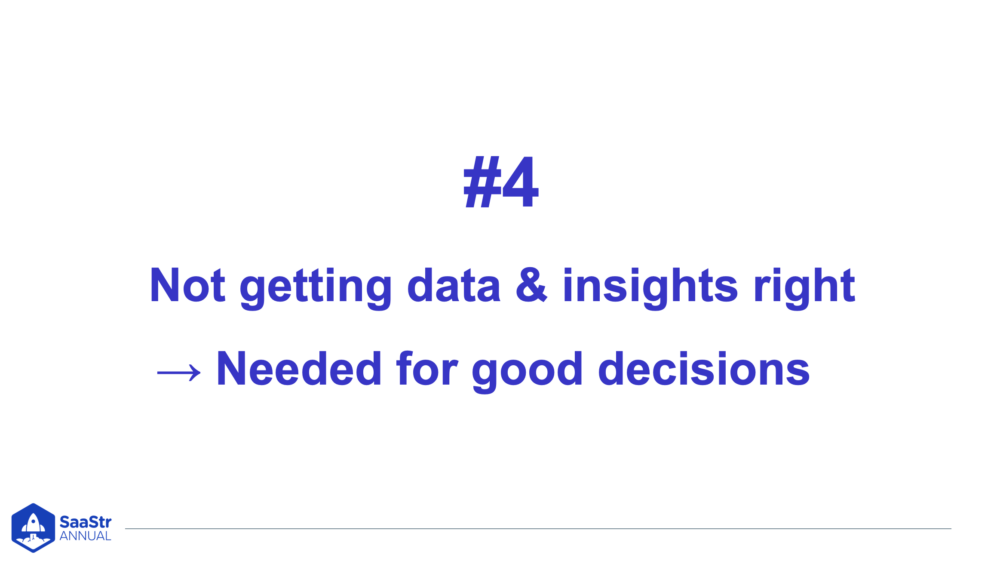
One mistake earlier-stage startup marketers make is not putting in place any marketing attribution tracking. It can be hard if you don’t necessarily have a supportive tech stack to see into the right data. It can prohibit you from creating that balanced scorecard metrics we mentioned because what’s the old phrase?, “I know half of my advertising dollars work. I just don’t know which half.”
But you don’t have to spend big marketing bucks to get attribution right. One example from Janine Pelosi, the former CMO of Zoom from their early days. By now, Zoom’s billboard and bus campaigns are widely known, but to optimize spend and return, Janine and team came up with the taglines for the billboards in-house. They didn’t hire a big branding agency or hire a research firm. But back when this campaign ran, and even still, they couldn’t find any metrics or vendors out there for the types of outdoor ads they were doing, so they created their own way of measuring it. They paid attention to where visits were coming from and would attribute branding if they were running outdoor advertising in those areas.
Mistake #5: Not Investing Early Enough in the Brand
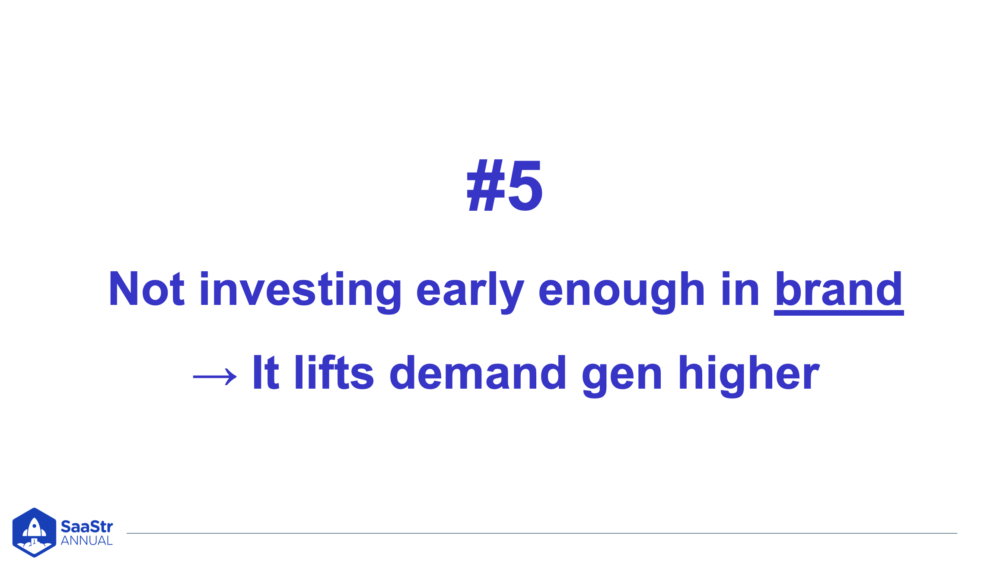
By investing early enough in branding, you lift demand gen higher. In the early days, you have to be pipeline-focused because it translates downstream to revenue, but it can be a mistake not to be more intentional and thoughtful of the brand earlier in the lifecycle and growth of the company.
Brand awareness does not equal throwing money at billboards. It should be a natural evolution. Databricks invested in the brand early, and it paid off with customers telling their story for them.
Rick explained, “Your brand is your reputation. Be thoughtful and intentional about what does your brand mean? What does it stand for? And then as you keep growing, really codifying that, making sure your visual identity, the language you use, the way you show up at events, all of that reflects the brand and creates a reputation. That’s the reputation you want in the market.”
Mistake #6: Not Having Strong Consistent Messaging
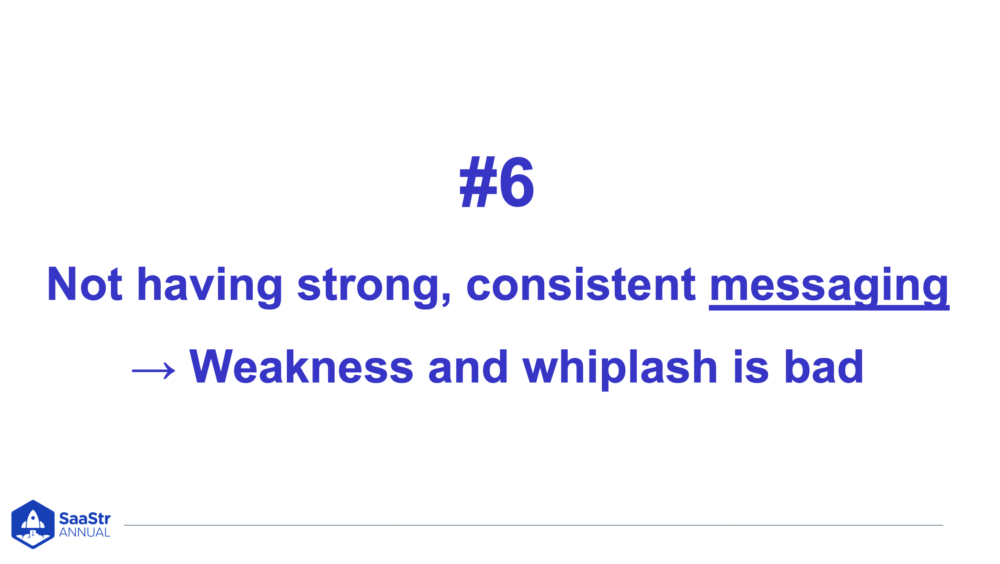
Sometimes, advertising and building brand awareness can feel boring when it follows the same ad format and messaging. However, research shows that the best awareness came from staying consistent rather than flip-flopping messaging.
“There’s a lot of pressure on marketing to come up with ideas,” Ryan from Okta explained. “It’s the creative field. What’s this new idea? And if you’re consistent with your messaging, it doesn’t look new, but it is important. If it’s connected back to why the company matters what you stand for and what is your purpose, that consistent messaging can be really impactful long term, and you have to resist the temptation to change just for change’s sake.”
The takeaway? It’s important for messaging to stay consistent throughout all channels and for marketers to have the stamina to stick with it. It’s easy to underestimate how long it takes to hammer a message into the market. It can be many quarters to years. Changing too frequently is a trap many marketers fall into. And remember, when you start getting bored with your messaging, customers are just starting to hear it.
Mistake #7: Not Being Your Best Self in Tough Times
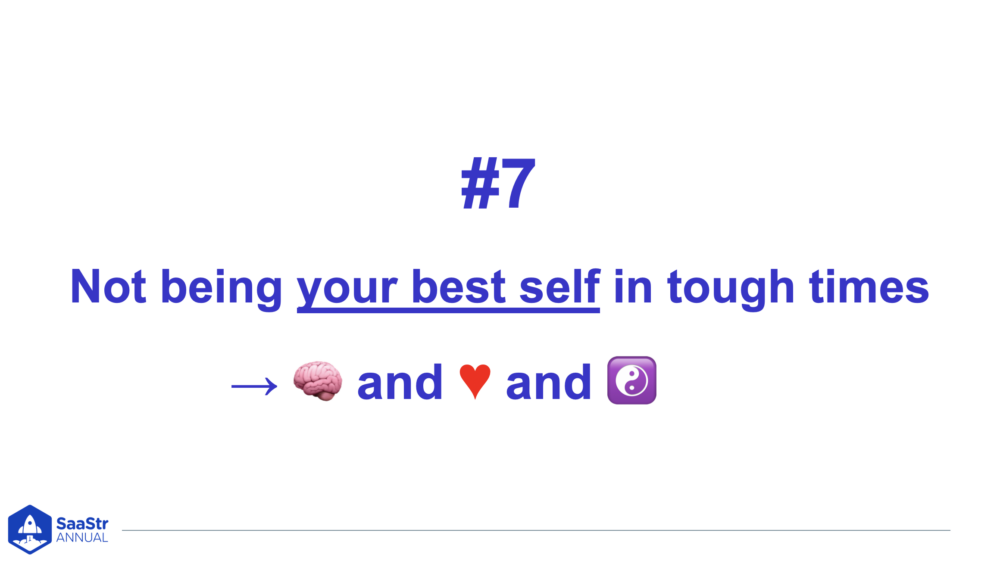
Some of the biggest regrets or mistakes people make are often when they’re going through a hard time — being tired, traveling a lot, having young kids, tension at home, hiring the wrong fit, etc. The tougher the time, the more it takes as a leader to be your best self and not be irritable, impatient, or rude.
Looking back at Zoom, they had a pretty historic growth period and went from 2400 employees to over 8000 in just 18 months, with unprecedented scale and growth.
“Growth hides problems flat out, right?” Janine explained. “The time to be tough on your team is when you are doing well, right? The time to be empathetic is when the company is having a really tough time and so often that is flip-flopped. And so the only way to get around that is to think about what could growth be hiding?”
Key Takeaways
- Participate in company strategy from the beginning as a CMO. Marketing should be built into the business, not bolted on.
- Build the right leadership team based on your company’s core values and hiring principles. Compromising on values almost never works out.
- Set the right metrics and goals to drive behaviors in a balanced way.
- Ensure your marketers have attribution tracking in place, can see the data, and use it to drive effective behaviors for growth.
- Invest in the brand and brand reputation early.
- Choose strong, consistent messaging over too many new ideas. As you start to get bored with your messaging, your customers are just beginning to hear it.
- Be your best self, especially during tough times. Growth hides problems, so when your team is doing well, you can be tougher. When the company is going through tough times, be more empathetic.
The post The 7 Biggest Mistakes CMOs Make (And How to Avoid Them) with the CMOs of Databricks, Zoom, and Okta appeared first on SaaStr.
via https://www.aiupnow.com
Amelia Ibarra, Khareem Sudlow
